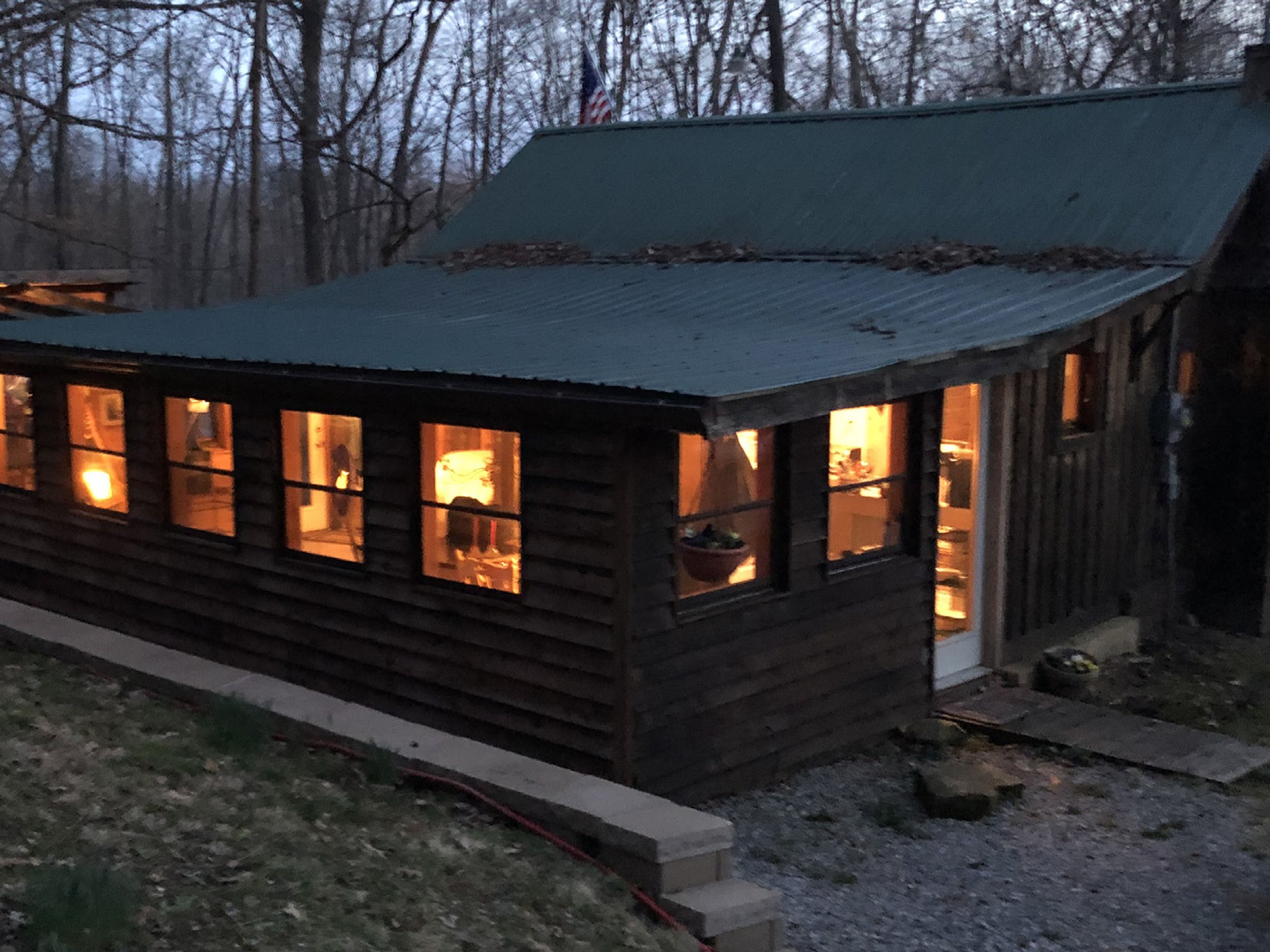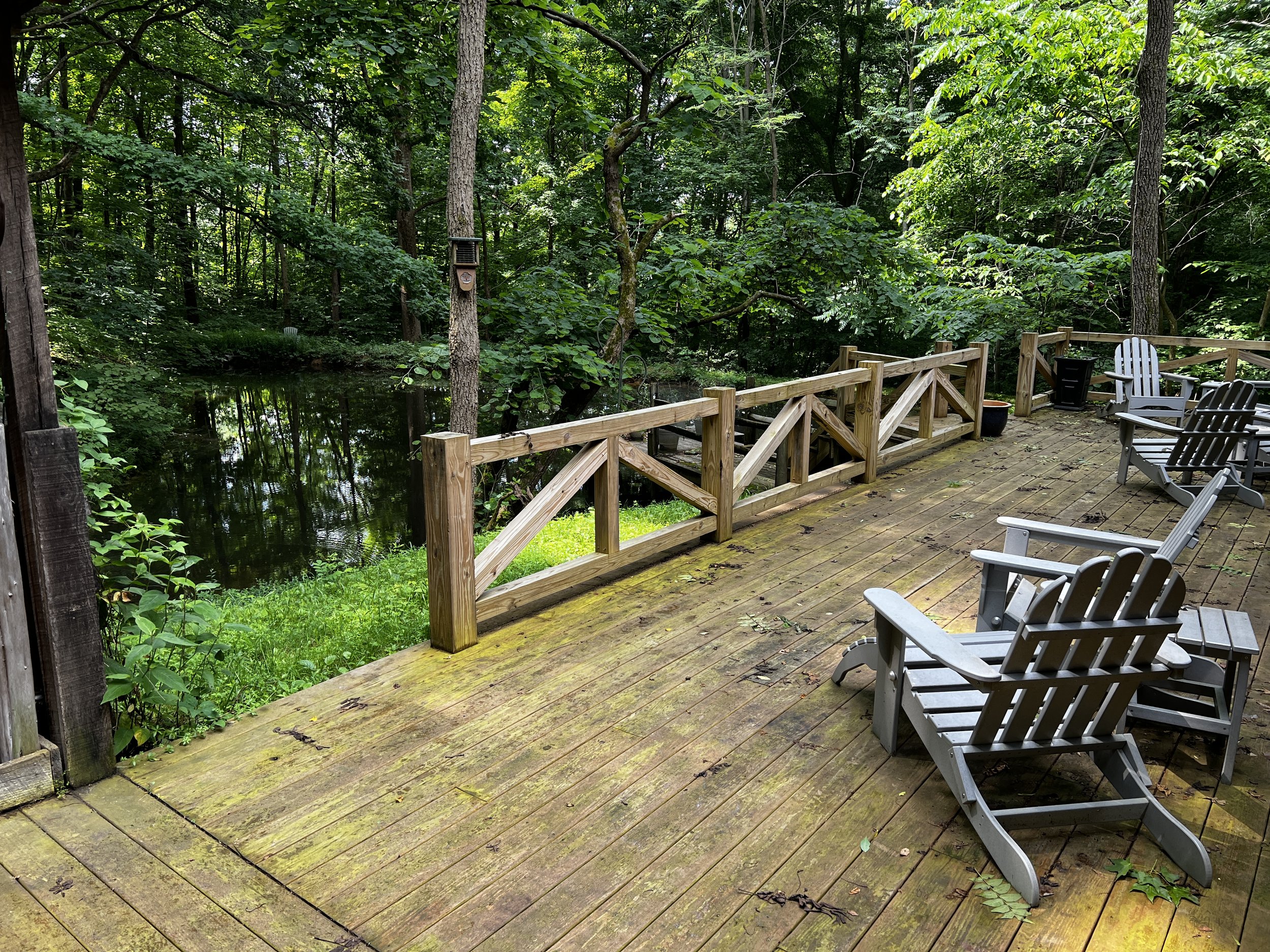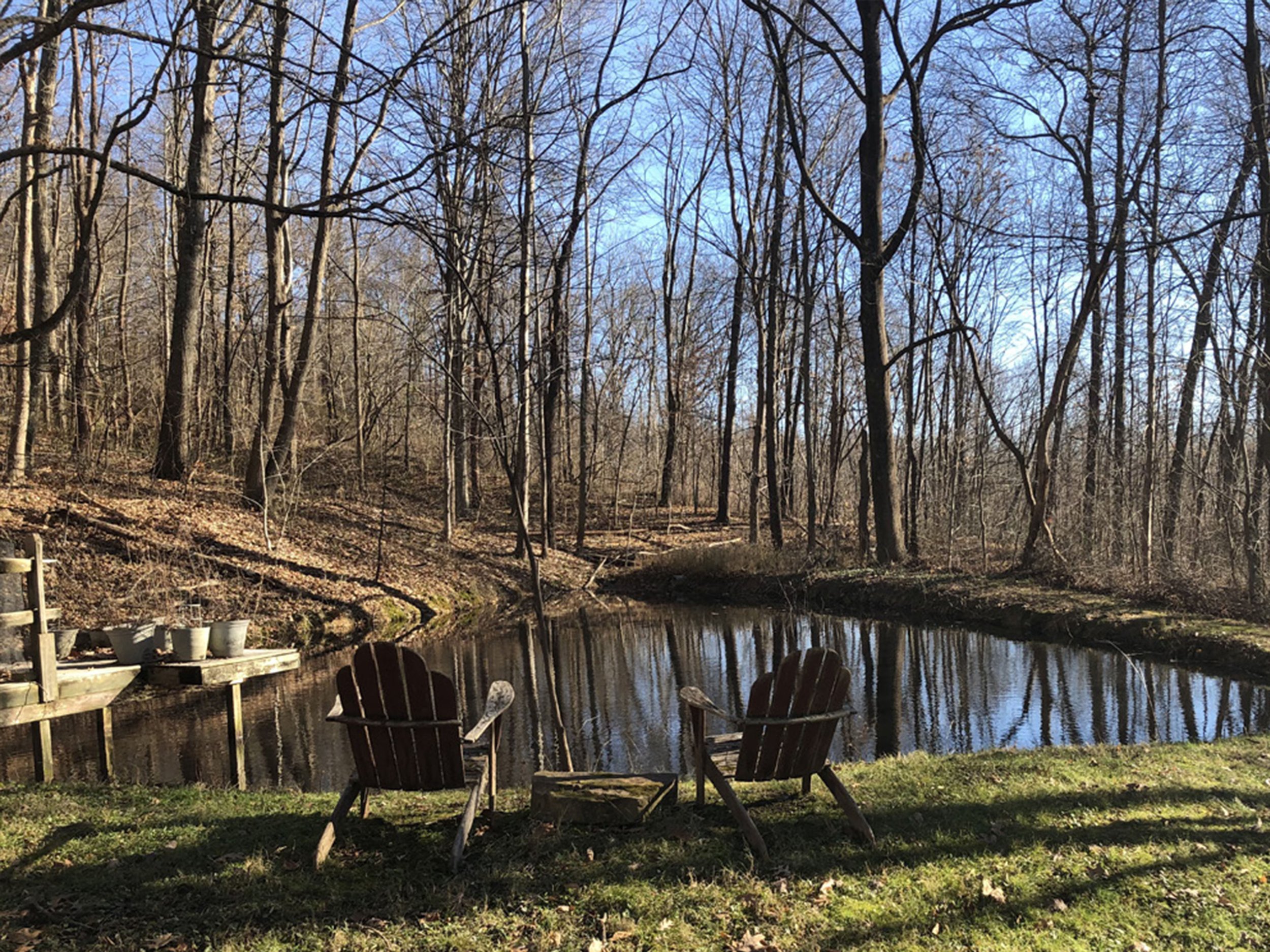Walworth Pond
Walworth Pond is an 11-acre parcel with a beautiful woodlands and a historic cabin that is generously being donated to the Arc by the Walworth family. The cabin sits halfway between the Highlands Nature Sanctuary and Fort Hill Preserve, which the Arc manages on behalf of the Ohio History Connection, and only a few miles south of Ravenwood Lodge. The cabin may very well have been an earlier house site of the Mulungeons, an intriguing mixed-race community that once occupied this region and has left behind a fascinating legacy. The historic cabin is currently undergoing extensive renovation for which funds are being sought. The finished value of the Cabin at Walworth Pond is estimated to be $202,000, $150,000 of which has been generously supplied through the philanthropy of Jim and Kathy Walworth. If you love bringing history to life, please direct your donation to the completion of the Cabin at Walworth Pond.
Lodging under development.
Just like our other historic renovations at Cave House, Barrett’s Millhouse, and Beechcliff, the Cabin at Walworth Pond will one day be made available to the public as an overnight rental. Please check back for updates!





Melungeon family in the Carmel region.. Photo: OSU and The Ohio Academy of Science

Melungeon family. Photo courtesy of Highland County Historical Society
Article first published in the Arc’s 2023-2024 Newsletter
Honoring the Legacy of Highland County’s Carmelites
Last year the Arc received a very intriguing email from Jim Walworth, a person with whom we weren’t yet familiar:
“Dear Ms. Stranahan, my wife Kathleen and I own 10.65 acres just outside of Carmel. It was purchased 22 years ago as a writer’s retreat for my wife, and we have both treasured the unique flora and fauna around our getaway cabin. It’s listed for sale but we have not yet found a suitable buyer. We are particular, and we are most concerned that the buyer has the like-mindedness to continue to treasure and preserve the place. We are moving to Florida in a few months, and as an alternative to selling it, we wanted to see if the Arc of Appalachia would be interested in accepting the property as a donation. I am going to be there tomorrow for my weekly trek from Dayton to do upkeep work. Would you be available to meet?”
A few of our staff gathered together to meet Jim and take a look. The property was located just a couple miles south of Ravenwood Lodge and the nearby crossroads settlement of Carmel in the remote heavily forested region that lies between the Highlands Nature Sanctuary and Fort Hill. The long narrow entrance lane to the property was heavily hemmed in on both sides with trees, and when we turned the final corner and the cabin came into view, we were smitten.
What did it remind us of, exactly, besides a romantic writer’s retreat? Maybe a north woods Adirondacks cabin? Or a southern Appalachian hunting cabin? Whatever it was, it was a woodsy cabin out of a novel that would make any naturalist swoon. The cabin was surrounded by a spacious deck overlooking a dark pond. Its waters were tinted by generations of fallen leaves, and a few newts hung suspended just below the surface. In the rear of the cabin was an outdoor kitchen that would captivate any western “cookie” (we confess our heads were still in romance novels), and above it all rose a splendid Appalachian woods. We immediately loved the place, and it didn’t take long for us to tell Jim and Kathy that we would be honored to be the recipient of such a generous gift.
Jim was completely forthright that they hadn’t been visiting the cabin as frequently as they did when their children were young. Although clearly they had invested considerable funds into keeping the place up, still, it had been uninhabited for some time and would need some work. He also warned us that the Health Department had only begrudgingly grandfathered in the septic system. “Okay, well,” we said. “No worries. We have a good relationship with the Health Department and we’ll work things out.”
Within six months of receiving the donation, Brit Wood, Arc’s facility manager, was tearing out his hair. He soon discovered that when he turned on the shower, water started spraying all over creation. Obviously the plumbing was going to need a wee bit of attention. And then, we were slapped with a violation notice from the Health Department for a faulty septic system and were forced to turn off the water until we had brought the system up to code. Many months later, when Brit was finally permitted to connect the well back up to the house and its brand-new septic system, nothing came out of the well but mud. Jim and Kathy were aghast at our stories of woe, and they generously offered, in addition to their earlier donation of land and equipment, an additional donation of $20,000 to help with the needed repairs.
However, not even these challenges were able to dampen our enthusiasm for the property. The forest alone, we believed, was worth preserving, and the old cabin, despite its demands, was truly a historic building.
Twenty years ago Kathleen had picked up a book by John Kessler, North from the Mountains, written by an author who was born and raised in Carmel. He had written about his research into the origin of peoples living in the immediate region who were variously known as Carmelites or Melungeons. They were a mixed race of people around which many mysteries swirled. Excitedly, Kathleen pointed out a photo in the book to her husband, Jim, of a Melungeon family living near Carmel. “Look, Jim, doesn’t this look like our cabin?” Intrigued, she invited the author to the cabin to chat.
John was happy to meet her and elaborated on what he had written about in his book. In the latter half of the 1800s, a reclusive community migrated into what was still a remote, wild area of Highland County, the land lying between what is now the Highlands Nature Sanctuary and Fort Hill. The people were financially poor but self-reliant; not formally well-educated but practiced in woodcraft and in the ways of the wilderness.
Their immediate roots were mostly from Magoffin County, Kentucky, but even there they were immigrants. Their earlier ancestral roots could be traced further south to the mountains and the Piedmont of Virginia, North Carolina, and South Carolina. Some people rumored they were descendants of the lost Cherokee Nation who hid in the hills when their tribe was forced west on the Trail of Tears. A local historian, Violet Morgan, in her book Folklore of Highland County, tells of people claiming to be remnants of the Shawnee Nation who lingered behind rather than be forced to reservations in Oklahoma as were their brethren. Some of the place names of their settlements in the Carmel region were derogatory slurs, such as Pocahontas Row. Others were colorful, as in, Coon’s Crossing. In census surveys, Melungeons were variously referred to as mestizos, mulattos, black, or white. Truth be told, most of the surveyors weren’t sure.
Living in eastern Highland County gave the Carmelites the security of having the southern hills at their back, and access to farms to their west, where they could supplement their income as laborers. They eked out a simple living on their own hardscrabble farms in openings of what were otherwise dense woodlands. They earned a reputation of keeping to themselves, which was not surprising considering they were often belittled for looking and living a bit differently from their neighbors. It was well known that if you treated them with respect and kindness, they were friendly and warm to neighbors and strangers alike.
Their lifestyle was poor, rural, and agrarian; and their food was supplemented by hunting and foraging. The porches of their cabins were often covered by strings of leather britches, dried apples, and various herbs for cooking and medicinal use. Violet Morgan states in her book that “they are fond of their pets and when a cabin door is opened, often chickens, dogs, cats, a pig, and young’uns tumble out good-naturedly together.” It is known that, even as late as 1938, running water, electricity, and indoor plumbing were not a sure thing in their community.
Violet had made friends among some of the Melungeons in her day, and her books are credited with bringing wider attention to the families and their ways, especially when she wrote of their practices of adorning the graves of their dead with crushed colored glass. Some locals claim that the Melungeons’ subsequent disappearance from the Carmel area was because of the unwanted curiosity they received from Violet’s publication. It is difficult to ascertain how much of the local accounts are fact and how much are folklore and hearsay. The descendants of the Melungeons, regardless, continue to survive in the eastern United States, even if less noticeably near Carmel.
Ethnological researchers have used DNA testing to confirm that Melungeons are indeed a mixed race of people of many ethnicities including Native American, Western European, Portuguese, and African. Researchers commented on facial features in some members that implied Native American roots, such as high cheekbones and jet-black straight hair, while other members from the same community had short, tightly curled hair. What is certain is that the Melungeans truly exemplify America as a melting pot of people and traditions.
Our nonprofit is committed to honoring and remembering the cultural history of the Carmel region in which two of the preserves we manage are embraced: the Highlands Nature Sanctuary and Fort Hill. We will probably never know if the cabin at Walworth Pond was originally built or occupied by Melungeons. What is certain is that the cabin gives us a visual reminder of what nearby Melungeon settlements may have looked like. We hope that the “Cabin at Walworth Pond” will long serve as an important touchstone for our region’s rich cultural legacies.

